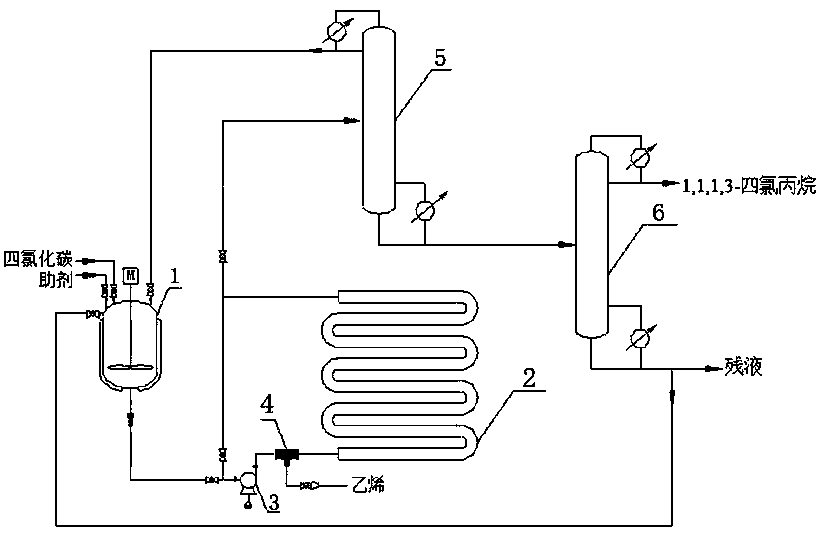Preparation method of 1,1,1,3-tetrachloropropane
A technology of tetrachloropropane and carbon tetrachloride, which is applied in the preparation of halogenated hydrocarbons, chemical instruments and methods, catalysts, etc. The effect of reactivity, less waste generation and high material utilization rate
- Summary
- Abstract
- Description
- Claims
- Application Information
AI Technical Summary
Problems solved by technology
Method used
Image
Examples
Embodiment 1
[0030] Intensified reactor 2 is a pipe reactor with an inner diameter of φ50mm and a length of 32.0m with an extracorporeal pumping cycle, filled with a porous iron packed bed filled with iron θ ring fillers; the preparation of 1,1,1,3-tetrachloropropane The process flow is:
[0031] 1) After mixing the additive (ethanol) and carbon tetrachloride in a molar ratio of 0.05:1, preheat it to 74.6°C in the preheating kettle 1, add the mixture into the intensified reactor 2, and use the circulation pump 3 to continuously extract The material in the upper part of the reactor is poured into the bottom of the strengthening reactor 2, and the mixture is forced to mix evenly and circulated for 6 hours;
[0032] 2) Raise the temperature of the intensified reactor to 89°C, a Venturi mixer is installed in the gas-liquid mixer 4, and ethylene is fed at a molar ratio of ethylene to carbon tetrachloride of 1.09:1.0, and in the Venturi mixer Mix well with the pumped and circulated liquid mater...
Embodiment 2
[0036] The difference between this example and Example 1 is that the ethylene, carbon tetrachloride and additive fractions obtained at the top of the tower in step 3) are recycled to step (1) for reuse. ~95% of the raffinate is recycled to step (2) for reuse. After the above-mentioned circular reaction is carried out once, 1,1,1,3-tetrachloropropane is finally obtained at the top of the second rectification tower 6 with a yield of 78%. , with a purity of 99.5%.
Embodiment 3
[0038] The difference between this example and Example 1 is that no auxiliary agent is added for the reaction, and the sampling analysis in step 2) shows that carbon tetrachloride is basically not converted.
PUM
 Login to View More
Login to View More Abstract
Description
Claims
Application Information
 Login to View More
Login to View More - R&D
- Intellectual Property
- Life Sciences
- Materials
- Tech Scout
- Unparalleled Data Quality
- Higher Quality Content
- 60% Fewer Hallucinations
Browse by: Latest US Patents, China's latest patents, Technical Efficacy Thesaurus, Application Domain, Technology Topic, Popular Technical Reports.
© 2025 PatSnap. All rights reserved.Legal|Privacy policy|Modern Slavery Act Transparency Statement|Sitemap|About US| Contact US: help@patsnap.com

